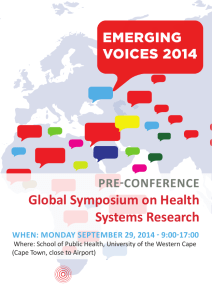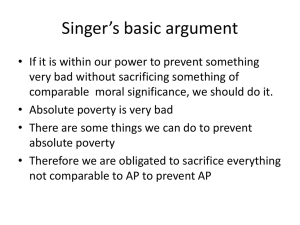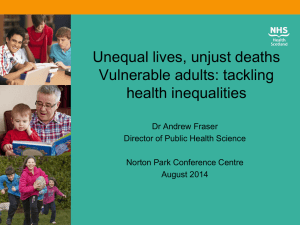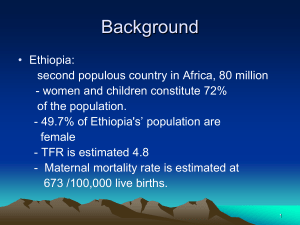Improving Wellness - Western Cape Government
advertisement
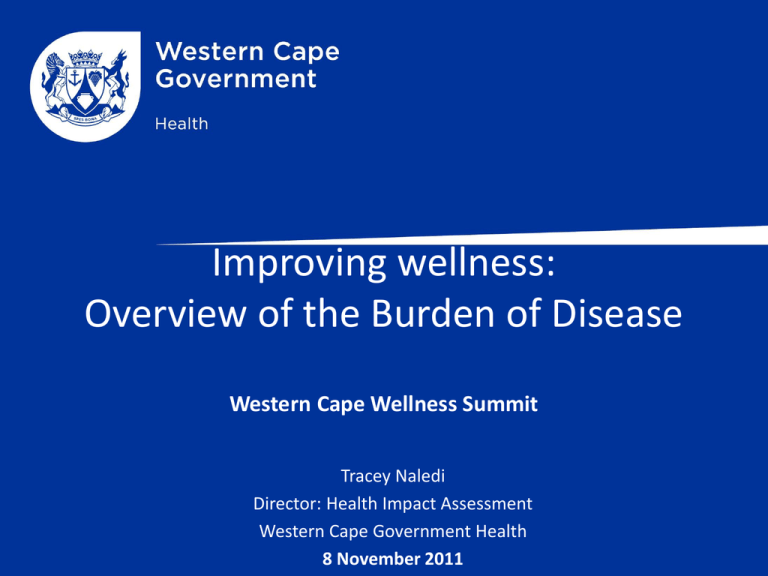
Improving wellness: Overview of the Burden of Disease Western Cape Wellness Summit Tracey Naledi Director: Health Impact Assessment Western Cape Government Health 8 November 2011 Some definitions from WHO • Health – a human right; far more than the absence of disease – resource for everyday life, not the objective of living – a consequence and a pre-requisite for development • Wellness – the optimal state of health with two components: • Realisation of one’s fullest potential (physically, psychologically, socially, spiritually and financially) • Fulfilment of one’s role expectations in the family, community, work, school, other settings What puts us at risk of ill health, e.g. violence Structural Societal Behavioural Biological Examples: Examples: Examples Examples: • Inequalities • Poor• parenting Demographic factors • Concentration of poverty • Norms that support violence • Marital • Psychological conflict and • High residential mobility • Availability of means personality who engage disorders in violence • High unemployment• Friends • Weak police/criminal justice • History of violent behaviour • Social isolation • Experienced abuse • Local illicit drug trade Source: TEACH VIP www.who.int/violence_injury_prevention/publications/violence/en/index.html 4 Development can also be a negative consequences What does our burden in WC look like? Western Cape Province Males Deaths 2009, N=25,729 Western Cape Province Females Deaths 2009, N=21,064 2,500 2,000 2,000 Deaths 1,000 1,500 1,000 500 Comm/Mat/Peri/Nutri HIV/AIDS and TB Comm/Mat/Peri/Nutri HIV/AIDS and TB Non-communicable Injuries Non-communicable Injuries Child Deaths 85+ 80-84 75-79 70-74 65-69 60-64 55-59 50-54 45-49 40-44 35-39 30-34 25-29 20-24 15-19 10-14 5-9 0 0 1-4 85+ 80-84 75-79 70-74 65-69 60-64 55-59 50-54 45-49 40-44 35-39 30-34 25-29 20-24 15-19 5-9 10-14 1-4 0 500 0 Deaths 1,500 What does our burden in WC look like? Western Cape Province Males Deaths 2009, N=25,729 Western Cape Province Females Deaths 2009, N=21,064 2,500 2,000 2,000 Deaths 1,000 1,500 1,000 500 Comm/Mat/Peri/Nutri HIV/AIDS and TB Comm/Mat/Peri/Nutri HIV/AIDS and TB Non-communicable Injuries Non-communicable Injuries HIV and TB 85+ 80-84 75-79 70-74 65-69 60-64 55-59 50-54 45-49 40-44 35-39 30-34 25-29 20-24 15-19 10-14 5-9 0 0 1-4 85+ 80-84 75-79 70-74 65-69 60-64 55-59 50-54 45-49 40-44 35-39 30-34 25-29 20-24 15-19 5-9 10-14 1-4 0 500 0 Deaths 1,500 What does our burden in WC look like? Western Cape Province Males Deaths 2009, N=25,729 Western Cape Province Females Deaths 2009, N=21,064 2,500 2,000 2,000 Deaths 1,000 1,500 1,000 500 Injuries Comm/Mat/Peri/Nutri HIV/AIDS and TB Comm/Mat/Peri/Nutri HIV/AIDS and TB Non-communicable Injuries Non-communicable Injuries 85+ 80-84 75-79 70-74 65-69 60-64 55-59 50-54 45-49 40-44 35-39 30-34 25-29 20-24 15-19 10-14 5-9 0 0 1-4 85+ 80-84 75-79 70-74 65-69 60-64 55-59 50-54 45-49 40-44 35-39 30-34 25-29 20-24 15-19 5-9 10-14 1-4 0 500 0 Deaths 1,500 What does our burden in WC look like? Western Cape Province Males Deaths 2009, N=25,729 Western Cape Province Females Deaths 2009, N=21,064 2,500 2,000 2,000 Deaths 1,000 1,500 1,000 500 Comm/Mat/Peri/Nutri HIV/AIDS and TB Comm/Mat/Peri/Nutri HIV/AIDS and TB Non-communicable Injuries Non-communicable Injuries NCD’s e.g. diabetes, hypertension, cancer 85+ 80-84 75-79 70-74 65-69 60-64 55-59 50-54 45-49 40-44 35-39 30-34 25-29 20-24 15-19 10-14 5-9 0 0 1-4 85+ 80-84 75-79 70-74 65-69 60-64 55-59 50-54 45-49 40-44 35-39 30-34 25-29 20-24 15-19 5-9 10-14 1-4 0 500 0 Deaths 1,500 What does our burden in WC look like? Cause of death profile, Western Cape 25% Injuries 20% Infectious and parasitic Respiratory infections 15% Stroke Cardiovascular disease Diabetes mellitus 10% Malignant neoplasms Respiratory disease 5% Other diseases Ill-defined 0% 1997 1998 1999 2000 2001 2002 2003 2004 2005 2006 2007 2008 Source: Western Cape BOD reduction project using StatsSA data Child Mortality is decreasing Source: Western Cape BOD reduction project using StatsSA data Infections and perinatal causes are our major problems Meningitis TB 2% 2% Septicaemia 3% Injuries 8% Other 8% Preterm 15% Malnutrition 4% HIV 8% Perinatal 35% Birth asphyxia 6% Sepsis 4% Pneumonia 14% Other perinatal 2% Congenital 8% Diarrhoea 16% Source: Western Cape BOD project Social determinants for child health Infant mortality rate per 1000 live births, South Africa Source: L. Lake Children’s rights to health presentation to WC Premier’s wellness summit, 8 November 2011. Department of Health (2002) South African Demographic and Health Survey 1998. Pretoria: DoH; World Health Organisation (2007) World Health Statistics 2007. Geneva: WHO. Both in: Bradshaw D (2008) Determinants of Health and their trends. South African Health Review.Durban: Health Systems Trust. Life course approach: South Africa Source: Saving children Pre-school Pre-School 15 Women’s Health • MDG 4 & 5: gender inequalities – increase women and children vulnerability to ill health • Intimate Partner Violence indicator for gender inequality • IPV results in high levels of mental health problems – especially depression, anxiety, PTSD and substance abuse • Teenage pregnancy, school completion, economic empowerment, crime and violence aggravated by IPV and rape Community-based randomly selected sample of adult men and women in Gauteng Province South Africa Women (victims) Men (perpetration) % % Any physical IPV 33.1 50.5 >1 episode of physical violence 30.8 43.4 Physical IPV in last 12 months 13.2 5.8 Any rape ever 25.2 37.4 Sexual IPV ever 18.8 18.2 With permisssion: Prof. Rachel Jewkes, Director: Gender & Health Research Unit, Medical Research Council of South Africa Community-based randomly selected sample of adult men and women in Gauteng Province South Africa Motivations for rape 80 Girl<15 yrs 70 Girlfriend 60 Non-partner Gang rape 50 40 30 20 Context of families and social environment important to consider 10 le a C pr es ee r ni n su g re Fu n lc oh o l m A B or ed o ng er A P S ex ua l en t it le m en t 0 With permisssion: Prof. Rachel Jewkes, Director: Gender & Health Research Unit, Medical Research Council of South Africa Injuries, WC 2009 18.1% Source: Western Cape BOD project Alcohol is an important risk factor Source: Western Cape Provincial Injury Mortality Surveilance System January – December 2008 Violence is CONCENTRATED Suburbs Zero Positive Unknown Total Khayelitsha 313 (15%) 527 (21%) 303 (8%) 1143 (13%) Gugulethu 97 (5%) 169 (7%) 143 (4%) 409 (5%) Nyanga 121 (6%) 161 (7%) 149 (4%) 431 (5%) Kraaifontein 73 (3%) 124 (5) 92 (2%) 289 (3%) Philippi 110 (5%) 125 (5%) 143 (4%) 378 (4%) . . Total 2135 (100%) . . 2460 (100%) . 3902 (100%) 8497 (100%) Approx. 50% of alcohol-related violence occurs in 5 areas Source: PIMMS (DoP analysis) DECREASE DEMAND FOR ALCOHOL EXAMPLES •Brief Interventions •Counter-messaging •Education •Recreation •Skills development •ECD •Mental Health •Social Cohesion •Urban upgrading M&E FOR OUTCOMES AND TARGETING OF INTERVENTIONS EXAMPLE •Detailed trauma surveillance REDUCE SUPPLY OF ALCOHOL EXAMPLES •Targeted implementation of Liquor Act •Community Mobilisation around liquor act and licensing CREATE SAFER DRINKING ENVIRONMENTS EXAMPLES •Social mobilisation for Safer drinking environments •Traffic calming •Infrastructural improvements •Urban upgrading HIV/AIDS AND TB New cases of HIV Source: ASSA 2011 Siamese twins: HIV and TB in areas of deprivation ~300,000 HIV infected individuals ~50,000 diagnosed TB cases per annum Of HIV-infected people, 86% are in 14 sub-districts Of TB diagnoses, 76% are in the same 14 subdistricts NON COMMUNICABLE DISEASES We are more overweight We smoke more We are less active Adolescents 70 National (M) 40 National (F) W Cape (M) 30 W Cape (F) 20 Percentage Prevalence (%) 50 Adults Men Women WC Men WC Women 60 50 40 30 20 10 10 0 0 Inactiv ity Smoking Ov erw eight Ov erweight Tobacco Inactiv ity Behaviour AND The trend is getting worse… Physical Activity Patterns in SA Youth Unhealthy food imports growing exponentially Presented with permission from David Sanders Unhealthy choices in tuck shops The right choice Is not the easy choice • Healthy foods prohibitively expensive, processed foods exceedingly cheap • There is a shortage of healthy low-fat food and little fresh fruit and vegetables in the townships. • Perceptions that fried & fast foods tastier, more “civilised” • Supermarkets make healthy foods available BUT – low prominence – Promotions: unhealthy foods – Advertising to children: unhealthy foods • Unsafe communities – decreased opportunities for physical activity Chopra M, Puoane T. Diabetes Voice 2003; 48: 24–6. & Temple, et. al., "Price and availability of healthy food: A study in rural South Africa." Nutrition Journal 1 (2010): 1-4. Farley et. al.. "Measuring the Food Environment: Shelf Space of Fruits, Vegetables, and Snack Foods in Stores." Journal of Urban Health 86.5 (2009): 672-682 These complexities present opportunities • Whole government, whole society action • Advocacy role of health sector for inter sectoral collaboration • Development of innovative systems for – Governance to manage partnerships and alliances beyond contractual arrangements – Evidence based inter-sectoral delivery and financing – Accountability • Strategic use of information for inter sectoral planning and M&E – Monitoring outcomes – Proactive rather than reactive response • Provincial Transversal Management System – Great opportunities to harness ideas and resources of all sectors Thank you

